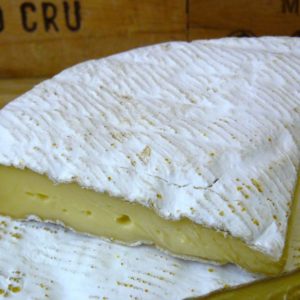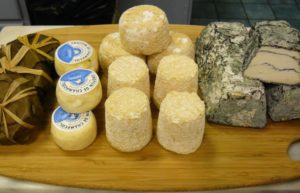
Editor’s Note: This sponsored column is written by Katie Carter, cheesemonger at Arrowine (4508 Lee Highway)
Spring is here and it’s a perfect time to enjoy supple, soft ripened cheeses. Also known as “bloomy rind”, this family of cheese is characterized by their soft texture and white rind. These cheeses are easy to enjoy and a perfect introduction into the world of cheese. The most famous of this style is Brie, a French cheese that is copied everywhere. Though production dates back to the eighth century, makers of traditional Brie were slow to designate (a form of copyright) the cheese and the name Brie can be used by cheesemakers anywhere.
 Unfortunately, Americans cannot enjoy the authentic Brie de Meaux or Brie de Melun here in the States, but makers of the real cheese usually make a pasteurized version for export. (Our laws say that raw milk cheeses must be aged for at least 60 days before sale and Brie is younger.) Cheese producer Rouzaire makes an excellent “Fromage de Meaux” and sometimes fabulous “Brie Fermier” arrives in the States. The flavors of these cheeses are creamy, mushroomy (due to the penicilium candidum rind), and the best have a distinct broccoli quality.
Unfortunately, Americans cannot enjoy the authentic Brie de Meaux or Brie de Melun here in the States, but makers of the real cheese usually make a pasteurized version for export. (Our laws say that raw milk cheeses must be aged for at least 60 days before sale and Brie is younger.) Cheese producer Rouzaire makes an excellent “Fromage de Meaux” and sometimes fabulous “Brie Fermier” arrives in the States. The flavors of these cheeses are creamy, mushroomy (due to the penicilium candidum rind), and the best have a distinct broccoli quality.
Do not limit yourself to Brie! There are hundreds of other excellent soft ripened cheeses. For a luscious treat, explore the world of cream-enriched cheese. Usually made with cow’s milk, these cheeses are sinfully delicious. A snowy white bloom (we can thank the French for coming up with the term “bloom” which refers to the growing fungus) encases a very soft and spreadable interior. The flavors can range from mild and buttery to farmy and more acidic. Look for Brillat Savarin, Pierre Robert, or Fromager D’Affinois. Pair these with a dry, white sparkling wine, such as Champagne or Prosecco.
Some of the best soft ripened cheeses are made from goat’s milk or a combination of milks. I am especially partial to the classic Loire Valley goat’s milk cheeses. Valancay, St. Maure, and Chabichou du Poitou are wonderful examples. Their rinds are a bit different from the Bries and double/triple cremes cheeses. Instead of the thick white penicillium candidum mold, these rinds are a fungus called geotrichum candidum. This rind is thinner and very wrinkly, resulting in a brainy appearance. They often have a layer of vegetable ash beneath the rind, which helps control acidity.
 Geotrichum rinds have less flavor, allowing the fresh milky flavors to shine. If made from pure goat’s milk, theses cheeses are usually higher in acidity with delicate herbaceous and minerally flavors. The best soft ripened goat’s milk cheeses are never overly “goaty”, a flaw attributed to poor farming and milk handling practices. This goatiness is actually a result of pheromones from the male bucks and can be controlled by keeping the does separated. Typically this style is made in small formats (usually about half pound) because goat’s milk curd is structurally weak. Pair soft ripened goat’s milk cheeses with a crisp Sauvignon Blanc.
Geotrichum rinds have less flavor, allowing the fresh milky flavors to shine. If made from pure goat’s milk, theses cheeses are usually higher in acidity with delicate herbaceous and minerally flavors. The best soft ripened goat’s milk cheeses are never overly “goaty”, a flaw attributed to poor farming and milk handling practices. This goatiness is actually a result of pheromones from the male bucks and can be controlled by keeping the does separated. Typically this style is made in small formats (usually about half pound) because goat’s milk curd is structurally weak. Pair soft ripened goat’s milk cheeses with a crisp Sauvignon Blanc.
Northern Italians make a delicious style of cheese called Robiola. This is a very broad term that includes many single or mixed milk options. Some are even washed rinds but I prefer the mixed milk, bloomy Robiolas. A family-run company called Guffanti ages and exports many Piedmont Robiolas. The most striking Robiolas are wrapped in various leaves, including chestnut, cherry, or even cabbage. With age, these cheeses develop significantly stronger flavors than the pure goat’s milk bloomies, yet rarely reach the strength of a washed rind cheese. The Beermonger and I recently enjoyed this style with Tank 7, a delicious saison from Boulevard Brewing Company.
Enjoy your weekend, Arlington!
Katie Carter is Arlington’s first and only ACS Certified Cheese Professional. She has worked in the cheese industry for ten years as a cheesemaker, cheesemonger, and educator. She can be found on Twitter @AfinaCheese. The views and opinions expressed in the column are those of the author and do not necessarily reflect the views of ARLnow.com.

